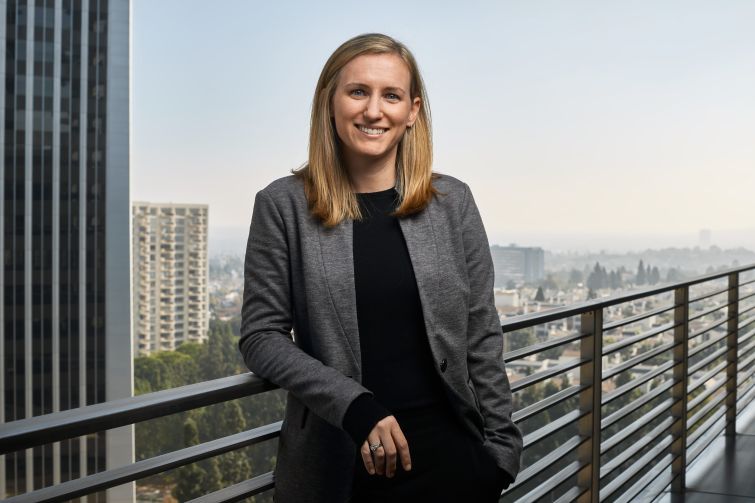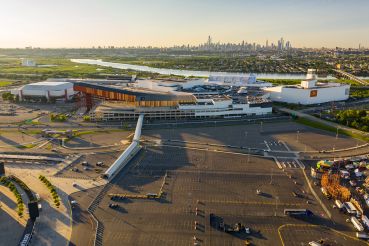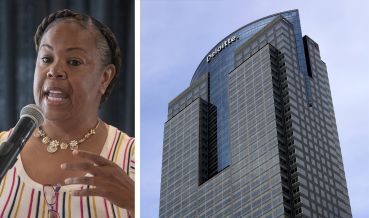Catch Me If You Canyon: Robin Potts Talks Key Market Opportunities
By Cathy Cunningham December 7, 2020 10:15 am
reprints
Had it not been for a job at Credit Suisse (CS), Robin Potts may have landed in entertainment. The Maryland native and Harvard graduate moved to L.A. to pursue her intended career on the business side of entertainment, but exposure to real estate transactions at the Swiss investment bank turned her head instead.
Fast forward 15 years, and Potts is now at the top of her game as co-head of real estate investments and director of acquisitions at Canyon Partners Real Estate, the investment arm of Canyon Partners, which has more than $26 billion in assets under management.
With a focus on both debt and equity investments, Potts has seen a unique opportunity set open up during the current crisis, and Canyon is making the most of it. Commercial Observer caught up with the L.A. resident to learn more about how her platform has fared and what she’s expecting from a market perspective in 2021.
Commercial Observer: Are you from L.A.?
Robin Potts: I’m not. I actually originally grew up in Maryland, and then Richmond, Virginia. But I’ve been in L.A. now for 16 years, so it’s definitely home at this point.
What brought you to L.A.?
I came out to L.A. after college for an investment banking job at Credit Suisse. From a very early age, I’d been interested in business and finance, and in college, I got the experience of combining business with running a theater production. I was very interested in pursuing the business side of entertainment, so I specifically sought out an investment banking job in L.A. rather than New York.
But while I was working at Credit Suisse in L.A., my coverage area included mortgage REITs, and exposure to real estate transactions. Ultimately, I found that incredibly stimulating in terms of combining finance, interpersonal relationships, and direct negotiations with the creativity of investing in physical assets and communities. So, rather than pursuing what I anticipated when I moved to L.A., I pursued real estate and private equity. Canyon — as a prominent firm based in L.A. with a significant real estate practice — was a top choice and I was very fortunate to secure an opportunity here. I’ve now been with the firm for 14 years.
Out of curiosity, which theater production were you working on?
It’s called the Hasty Pudding Theatricals. It’s actually the oldest running theater production in the U.S. and an annual, very large theater production produced by Harvard undergrads every year. As a college student, it was the most significant large-scale business experience that was available in terms of running a business, managing a team, managing a budget, executing on a business plan with deadlines, and also the creative aspect —and I think a lot of those elements exist within real estate.
Are any of your family in real estate?
My father and grandfather were both in the banking and the mortgage industry as well, so at every dinner table conversation, we’d talk about the daily news events in The Wall Street Journal or business trends. So, I got that exposure early and often from my family, which was a really tremendous way to be engaged at quite an early age.
You moved to Canyon in 2006, just before the global financial crisis (GFC). How was that experience for you, in terms of the deals you were working on and the lessons you learned?
Canyon is very unique in that we have both a debt and an equity discipline; our platform spans a wide range in terms of the types of opportunities that we can pursue. So, when going through different points in a market cycle, it’s an incredibly entrepreneurial platform that’s able to capture a changing market environment. During the GFC — which was quite different than what we’re going through this year with COVID — there were just a tremendous number of opportunities to acquire or recapitalize loans and assets at a discount. So, we were stepping into distressed situations, from mid-construction projects to existing assets, that had upside-down capital stacks.
Having a sizable portfolio going into the GFC and asset managing investments through that type of a period is an invaluable learning experience. Our team had the opportunity to see how a crisis can create not only opportunities on the new investment side, but challenges within an existing portfolio, which we worked through.
It feels like everyone is waiting for a big wave of distress as a result of this crisis. Do you think we’ll see it?
It’s an interesting differentiator this time. Obviously, this is not a financial crisis, it’s a health crisis. And it’s had such a unique set of ramifications for commercial real estate that are quite different than what we observed during the GFC. The GFC hit assets and valuations fairly indiscriminately, and it also created true sellers. In many cases, that was driven by the fact that balance sheets — at the corporate level and the individual asset level — were very highly leveraged going into the GFC, which made the unwinding of those much more tangible.
Coming into COVID, the commercial real estate industry broadly had required much more equity of owners. So, the over-leveraged nature of what happened during the GFC, at the asset level at least, has largely not been the case coming into COVID. And, as a result, you’re not seeing the level of distressed sales at the asset level that you saw coming out of the GFC. Lenders are, in many cases, much more willing to work with their borrowers on forbearance and to give owners time to restabilize properties. So, it’s just playing out much differently because it’s a very different type of crisis.
Additionally, unlike during the GFC, there’s a tremendous disparity between how different property types are being affected, with certain asset classes like multifamily and industrial now being at valuations at — or certain cases potentially above – pre-pandemic levels, while other asset classes are much more affected by the inability to congregate and having a much more difficult time on the revenue side like hotels and retail.
To answer your question, there was an initial flurry of activity in April for certain types of investors — mortgage REITs and certain private funds — who had utilized mismatched leverage at the corporate level, with repo facilities and warehouse facilities that had margin call abilities. And so, there was an initial trigger of sales that’s really resolved itself at this point, and people have been able to reset their balance sheets.
I think the working through of assets that ultimately may be underwater going forward is going to unfold in a more delayed fashion. As I mentioned, a lot of the forbearance agreements that were provided by lenders at the beginning of the crisis were typically about six months in nature, maybe in some cases longer, so you’re just getting to the point now where those forbearance agreements are expiring, and lenders and borrowers are reevaluating where an asset stands, and its restabilization. And they’re either entering into a new modification, or determining that they need to go another route in terms of a loan sale or an asset sell or recapitalization, whatever the case may be. I think that will take time to play out in 2021.
How has Canyon’s portfolio fared during COVID?
COVID absolutely presented challenges, and unique challenges that were very hard to anticipate. And, when you’re faced with a new set of challenges that no one’s ever faced before, the strength of your original underwriting and the strength of your borrower, partner or lender relationships all come into play in a really important way.
We were very fortunate to be able to work through a number of different issues. So, for example, we’re a very active construction lender, and in certain jurisdictions immediately coming into COVID, construction was deemed a non-essential business. And so, some of our projects were required to stop work for a period of time, which requires potential changes to project budgets and schedules. But we were able to work through all of those types of issues within our portfolio and, of course, construction was able to resume after a certain period of time.
Issues like that create a very asset management-intensive period and we’ve always believed in having a deep bench in terms of an in-house asset management team, and proactively staying on top of all of the activity within our portfolio through easier times and harder times.
I think the other element that was unique is that we did not utilize repo facilities across our real estate platforms, so we weren’t subject to any margin calls. That enabled us to be much more proactive on new originations. Additionally, we came into the pandemic underweighted to hospitality and retail, so that certainly served us well from a portfolio perspective.

Speaking of asset classes, the three safe havens today seem to be multifamily, industrial and life science.
Yes. Life science is certainly an area that we’re spending much more time on, but we do not currently have exposure in our current portfolio.
How has your deal approach changed post-COVID?
COVID is a world where you can’t travel and it’s rare to have a face-to-face meeting. The strength of your existing relationships, and the reputation that you’ve built in the market — in our case, over the course of decades — is really important in terms of being that call that a borrower or partner on the equity side knows will show up, in terms of certainty of execution and the ability to transact. Our repeat sponsor relationships are incredibly important to us and those direct originations have been a big focus of ours.
But there’s a number of different trends that we’re focused on. Coming out of the GFC, note sales were very prevalent as lenders, primarily banks, cleaned up their balance sheets. Note sales really have not existed as an opportunity set for essentially a decade, but coming out of COVID, you now have a tremendous amount of loan sales that have been launched.
We’ve seen over $6 billion of mortgages come to market from a variety of different lender types who are looking to reposition their balance sheet. We were able to execute on a sizable portfolio acquisition this fall, where we acquired a $314 million loan portfolio across six different mortgages. So, we’re excited about that new, expanded opportunity set being available. I do expect note sales to continue to unfold through 2021 as lenders continue to evaluate their exposures. That’s something that we’re keenly focused on and have been spending a lot of time on, buying performing loans as well as non-performing loans.
We’re also very keyed in on the accelerated demographic trends that are occurring as a result of COVID, and the migration toward non-gateway cities and secondary markets that are more affordable. The trend was already occurring pre-pandemic, but post-pandemic, those shifts have increased. So, we are actively trying to lean into that opportunity and some of the secondary markets that we find most interesting — so cities like Charlotte, Raleigh, Nashville, Austin, Dallas, Atlanta, Phoenix, Vegas, Portland and Seattle. The accelerated shifts have made them even more interesting.
Do you still see L.A. as a market that you want to continue to be heavily invested in?
We have a meaningful portfolio within L.A. and Southern California, and we absolutely will continue to look at opportunities in this market. But it’s deal-by-deal underwriting, and the fundamentals in L.A. and New York have shifted versus where they were pre-pandemic. So it’s a matter of the specific property type; overall, what is the basis at which you’re investing, and who is the borrower and partner relationship. It’s just very specific.
And there’s different dynamics within the Los Angeles submarkets. So, the deep dive underwriting approach is what we focus on across the board, but particularly in the markets that have been most affected by COVID. Getting very granular in underwriting in order to evaluate new investments is quite critical.
Any thoughts around how non-traditional lenders have fared overall during this crisis versus traditional?
I think traditional lenders continue to be much more constrained than non-traditional lenders. And that bifurcation, in terms of constraints on traditional lenders, existed before the pandemic, with banks being subject to Basel III and the [high volatility commercial real estate] rules. The overall regulatory requirements existed before, but they’re heightened post-pandemic in a meaningful way. And so, broadly speaking, the banking universe activity remains very reserved, and there’s a haves and have nots universe in terms of what types of deals are financeable. I think at the top of the list for banks is sponsorship post-pandemic; they’re really reserving their capital for their best relationships.
And then, of course, from a property type perspective, it’s not possible to secure bank financing for a hotel or retail. Banks lean into multifamily, and industrial and office with strong rent rolls, and they pull back on their leverage levels. So, for the non-traditional lender universe, there’s a broadened opportunity set, and non-traditional lenders with dry powder can select interesting ways to deploy capital. We’re very active on the debt side in terms of providing senior loans, mezzanine loans and preferred equity.
And so, on the subordinate side, where the banks have pulled back, in terms of their advance rates, we’ve had a larger piece of each capital stack that’s available for us to play in. And then, for the areas of the market where there may be no bank quote available — even at a low leverage level — we can provide a senior loan. So, for the non-traditional lenders that did not have to face major shifts in their balance sheets or margin calls and could still originate through this crisis, the opportunities have been quite interesting.
Any thoughts in the CMBS market today? It came to a screeching halt after the pandemic started, but we’re seeing activity recently.
I agree with your assessment. The CMBS side is definitely thawing and, ultimately, should start playing a greater role again in 2021. But CMBS, previously, was a major provider for hospitality and retail, and it’s going to be a missing financing source for those asset classes for the foreseeable future.
What was the biggest challenge for you personally, doing business during a global pandemic?
There’s an element missing in terms of face-to-face interaction over the phone or over Zoom. Obviously, it’s not quite the same as that energy that you get by collaborating and sharing ideas in person, whether it’s internally across the team, or externally with market relationships. It’s such a relationship-oriented, travel-oriented industry, and I’m quite eager to return to those elements of the job.


